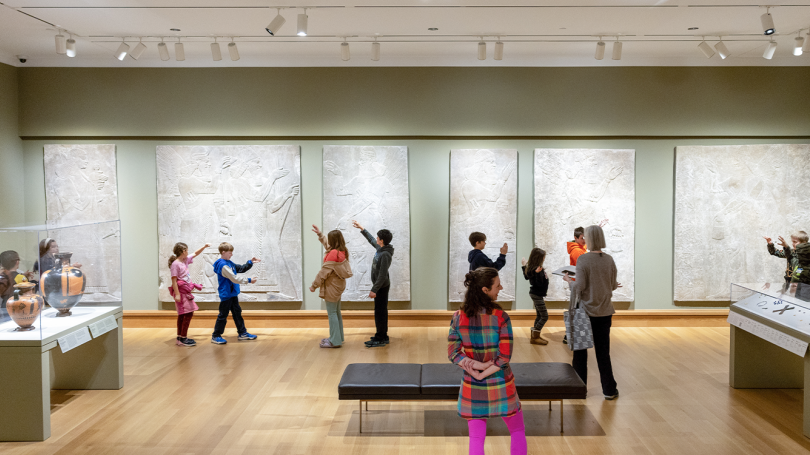ASHLEY OFFILL, Curator of Collections
Hood Quarterly, winter 2025
In the late summer of 2024, a team of Hood Museum staff members crouched on the ground or sat on the couch in front of the carved gypsum panel depicting an apkallu (a supernatural figure) from Ashurnasirpal II's Northwest Palace at Nimrud (present-day Iraq). As they adjusted the projector that rested on the floor in front of them, a wash of color slipped over the textured stone, an echo of the brightly colored pigments that once covered the surface of the reliefs. While only an initial test of a project that will take shape over several months, this exhilarating glimpse into the past is one that all visitors to Kim Gallery will be able to share in the second half of 2025.
Kim Gallery, which is quite literally anchored by the monumental reliefs from the Northwest Palace, is an essential educational space at the Hood Museum of Art. While the installations within this space have remained largely the same since the reopening of the museum in 2019, eagle-eyed visitors may have noticed that changes are starting to appear throughout the gallery. We are now halfway through a multi-stage reconsideration of Kim Gallery that will culminate in summer 2025 with a reinstallation of the gallery and light projections that examine the possible original colors of the reliefs. The exhibition, titled Stone, Sand, and Clay: Connecting Cultures in the Ancient Mediterranean, will coincide with the Hood Museum's fortieth anniversary celebration in the fall as well.
This new installation will plumb the depths of the Hood Museum's collection of ancient art, bringing teaching favorites into the galleries alongside rarely seen objects. A cuneiform brick from a ziggurat in Nineveh and a cuneiform cylinder associated with the Assyrian king Sargon II and his construction of a new capital city will expand our understanding of Ashurnasirpal II and Assyrian kingship in general. A selection of ancient oil lamps will illuminate one of the ways people brought light into daily life, while luxurious glass perfume and ointment vessels will join everyday cups and bowls to explore the range of functional objects in the ancient Mediterranean. The Assyrian reliefs will be joined by a selection of other ancient reliefs, demonstrating the lasting power of this sculptural technique as well as their uses for propaganda, commemoration, and memorials.
Early stages of the project included a Conversations and Connections program in summer 2023 where I explored various thematic connections to the Assyrian reliefs through a range of collections objects brought out from storage. In addition to providing a rare look at museum works outside the boundaries of frames or cases, this program allowed visitors to give feedback on themes and objects that interested them. This information informed the range of objects that will feature in the upcoming reinstallation. Similarly, a survey launched in May 2024 alongside new labels in Kim Gallery invited audiences to share both what they enjoy about the gallery in its current form and what they hope to see and learn in the future. The new labels also demonstrated a different approach to the objects currently on view in the gallery. They consider different moments on the paths of these objects to the Hood Museum of Art, as well as why and how they were collected, instances where they have been altered by their owners, and research that has been conducted on them here at Dartmouth. Through this exploration of object biographies, we uncover new ways of looking at some of the most familiar works in the museum's collection.
An essential part of this project has involved diving into the history of the collections at Dartmouth, which predate the Hood Museum by almost two centuries. Did you know, for instance, that the panels of the Assyrian reliefs were once divided up on campus, with three panels placed in Carpenter Hall and three panels in the Wilson Hall Museum from 1951 to 1984? The renewed examination of ancient art and its place at Dartmouth is a fitting focus for the Hood Museum in its fortieth year, and one that we hope will encourage new understandings, inquiries, and engagements for our audiences for years to come.


